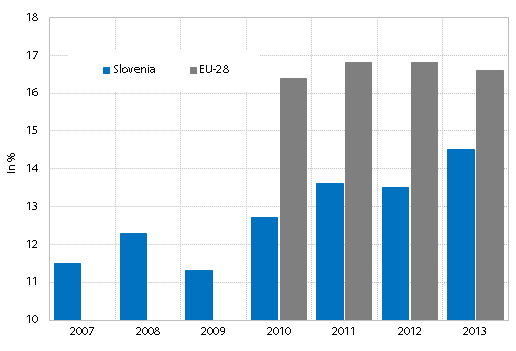MATERIAL WELL-BEING - Poverty and social exclusion
The at-risk-of-poverty rate is the percentage of persons living in households in which disposable income (including social transfers and pensions) is below the at-risk-of-poverty threshold. The at-risk-of-poverty threshold is set at 60% of the median disposable income of all households, taking into account the OECD equivalence scale. Increase in the at-risk-of-poverty rate is linked with the decline in well-being because it increases material poverty and social exclusion of the population.
Figure: At-risk-of-poverty rate, Slovenia and the EU, 2007–2013 (%)

Source of data: Eurostat.
Note: Data for EU-28 are available only from 2010 on.
The at-risk-of-poverty rate in Slovenia in 2013* increased by 1 percentage point to 14.5% of the population. In the 2009–2013 period it went up by 3.2 percentage points, so that in 2013 50,000 more people lived below the at-risk-of-poverty threshold than in 2008, largely as a consequence of the economic crisis. Despite the increase, the rate is lower than the EU average, but the gap is rapidly closing, since in the EU the rate has already started to decline. During the crisis, the at-risk-of-poverty rate in Slovenia increased the most for unemployed persons; in 2013 it was 46.2%, 8.6 percentage points higher than in 2008. During this period the at-risk-of-poverty rate also increased significantly for families with children. In Slovenia above-average rates are recorded for single persons, particularly older women. In 2013, Slovenia was in the top three countries as regards the at-risk-of-poverty rate for women aged 75+. Above average rates were recorded for households with no active members, single parent households with at least one dependent child, and one person households (65 years or more).
Results of supplementary indicators show:
In 2013, the share of households stating that they have difficulties managing to live on their income (great difficulty, difficulty, some difficulty) was 72.4%, 6.8 percentage points higher than in 2012. This was the highest share after 2005 and much higher than the EU average (57.6%). Provisional data for 2014 indicate a slight decline.
The share of materially deprived people in Slovenia rose during the crisis to 17% in 2013, which is 2.7 percentage points more than in 2007. In the 2008–2013 period the share in Slovenia did not change much and is still below the EU average, which in 2013 was 19.6%. In Slovenia, the share of materially deprived is the highest among people aged 65+ (18.2%).
* The calculation of the at-risk-of-poverty rate for 2013 is based on income from 2012.
